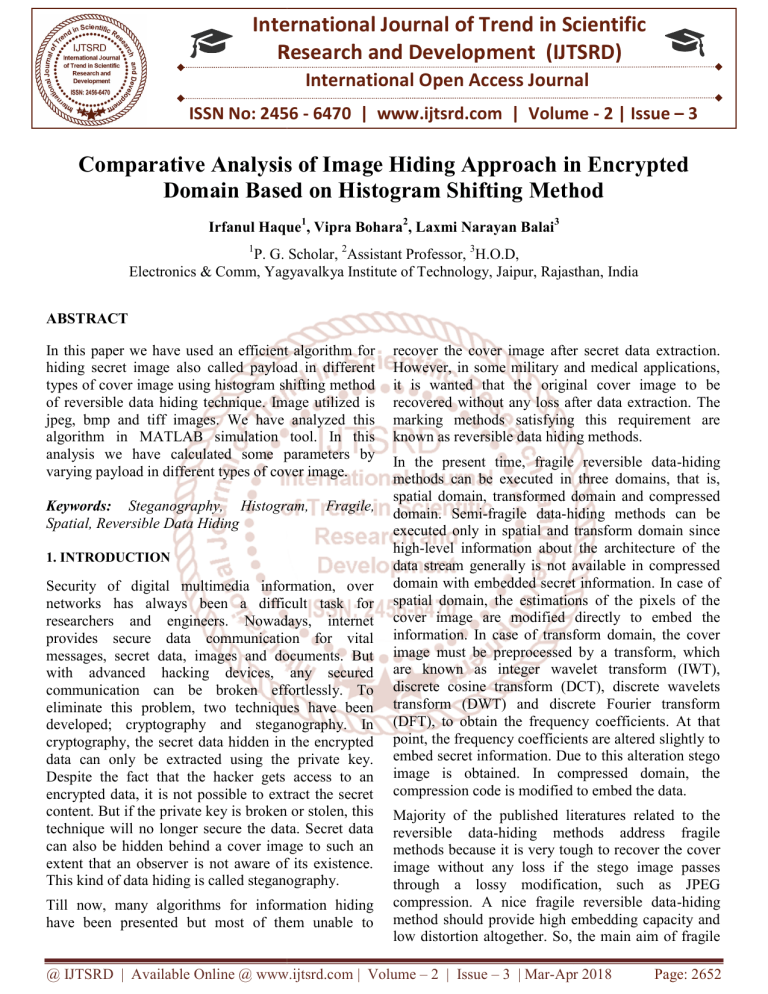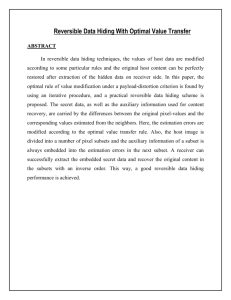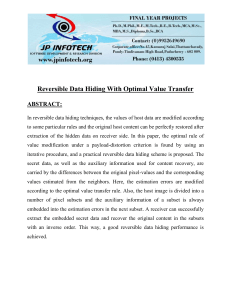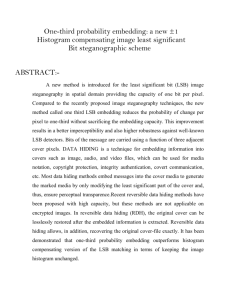
International Journal of Trend in Scientific
Research and Development (IJTSRD)
International Open Access Journal
ISSN No: 2456 - 6470 | www.ijtsrd.com | Volume - 2 | Issue – 3
Comparative Analysis of Ima
Image
ge Hiding Approach in Encrypted
Domain Based on Histogram Shifting Method
Irfanul Haque1, Vipra Bohara2, Laxmi Narayan Balai3
1
P. G. Scholar
Scholar, 2Assistant Professor, 3H.O.D,
Electronics & Comm, Yagyavalkya Institute of Technology, Jaipur, Rajasthan, India
ABSTRACT
In this paper we have used an efficient algorithm for
hiding secret image also called payload in different
types of cover image using histogram shifting method
of reversible data hiding technique.. Image utilized is
jpeg, bmp and tiff images. We have analyzed this
algorithm in MATLAB simulation tool. In this
analysis we have calculated some parameters by
varying payload in different types of cover image.
Keywords: Steganography, Histogram,
Spatial, Reversible Data Hiding
Fragile,
1. INTRODUCTION
Security of digital multimedia information, over
networks has always been a difficult task for
researchers and engineers. Nowadays, internet
provides secure data communication for vital
messages, secret data, images and documents. But
with advanced hacking devices, any secured
communication can be broken effortlessly. To
eliminate this problem, two techniques have been
developed; cryptography and steganography. In
cryptography, the secret data hidden in the encrypted
data can only be extracted
tracted using the private key.
Despite the fact that the hacker gets access to an
encrypted data, it is not possible to extract the secret
content. But if the private key is broken or stolen, this
technique will no longer secure the data. Secret data
can also
lso be hidden behind a cover image to such an
extent that an observer is not aware of its existence.
This kind of data hiding is called steganography.
Till now, many algorithms for information hiding
have been presented but most of them unable to
recover the cover image after secret data extraction.
However, in some military and medical applications,
it is wanted that the original cover image to be
recovered
ered without any loss after data extraction. The
marking methods satisfying this requirement are
known as reversible data hiding methods.
In the present time, fragile reversible data-hiding
data
methods can be executed in three domains, that is,
spatial domain, transformed domain and compressed
domain. Semi-fragile data-hiding
hiding methods can be
executed only in spatial and transform domain since
high-level
level information about the architecture of the
data stream generally is not available in compressed
domain with embedded
edded secret information. In case of
spatial domain, the estimations of the pixels of the
cover image are modified directly to embed the
information. In case of transform domain, the cover
image must be preprocessed by a transform, which
are known as integer
er wavelet transform (IWT),
discrete cosine transform (DCT), discrete wavelets
transform (DWT) and discrete Fourier transform
(DFT), to obtain the frequency coefficients. At that
point, the frequency coefficients are altered slightly to
embed secret information.
ation. Due to this alteration stego
image is obtained. In compressed domain, the
compression code is modified to embed the data.
Majority of the published literatures related to the
reversible data-hiding
hiding methods address fragile
methods because it is very tough to recover the cover
image without any loss if the stego image passes
through a lossy modification, such as JPEG
compression. A nice fragile reversible data-hiding
data
method should provide high embedding capacity and
low distortion altogether. So, the main
m
aim of fragile
@ IJTSRD | Available Online @ www.ijtsrd.com | Volume – 2 | Issue – 3 | Mar-Apr
Apr 2018
Page: 2652
International Journal of Trend in Scientific Research and Development (IJTSRD) ISSN: 2456-6470
2456
methods is to provide a secure channel to protect
secure communication among legitimate users.
2. STEGANOGRAPHY
Information Hiding methods have been gaining much
attention today. The main goal for this encryption and
decryption processess is that here the secret
information is completely hidden and therefore does
not gain attention. This process of hiding secret
information
is
known
as
Steganography.
Steganography or Stego as it is regularly referred to in
the IT sector, literally signifies,
es, "Secured writing"
which is taken from the Greek language.
Steganography is described by Markus Kahn as
follows, "Steganography is the science and art of
communicating in a manner which hides the presence
of the communication. The objective of
Steganography
aphy is to hide data inside other harmless
data in a way that does not enable any attacker to
even detect that there exists a second data".
Steganography can be utilized in a huge amount of
data formats [5] in today’s digital world. The most
fundamental data
ta formats utilized are .doc, .bmp,
.jpeg, .gif, .txt, .mp3 and .wav essentially because of
their popularity on the Internet and the easy process
of using the steganographic tools that depends on
these data formats. These data formats are also
popular due to their relative ease by which noisy or
redundant information can be extracted from them
and replaced with a hidden data.
3. HISTOGRAM SHIFTING
The basic histogram shifting scheme for reversible
data hiding was first introduced by Zhicheng in 2006.
In this
is proposed scheme, the image histogram is
generated at first by considering all the pixel values of
an image. To insert secret data, some pixel values are
changed. At the receiver, for extracting the concealed
data, the changed pixels are returned back to their
actual condition. Thus the reversible data hiding
scheme is obtained. During data embedding, at first
from the image histogram the pair of zero and peak
points are searched. The zero point refers to the pixel
with least repeated value and the peak ppoint refers to
the pixel with most repeated value in the image
histogram. Here, data is carried only by the peak pixel
values. The peak pixel value is modified by 1 closer
to the zero point for the corresponding secret data O.
Where the data is 1 the peak pixel values remain
unchanged. The pixels in between the pair of peak
and zero points are also modified by 1 to a value
closer to zero point but they do not carry any secret
data. After processing all the pixels sequentially, the
stego-image is produced. Att last, the processed-image
processed
and the pair of peak and zero points are ready to
transmit. At the receiver, the concealed data is
regained and the actual image is regenerated. Lena
image and its histogram are shown in Fig. 1 & Fig. 2
respectively.
Fig-1: Lenaa image
Fig-2:
2: Histogram of Lena image
4. PROPOSED WORK
In our work we have comparatively analyzed an
algorithm for finding various features of cover image
by hiding different types of payload using histogram
shifting method of reversible data hiding procedure.
proced
All the simulations are carried out in MATLAB
simulation tool. Fig. 3 shows the algorithm to hide
image in cover image and to obtain the stego image.
@ IJTSRD | Available Online @ www.ijtsrd.com | Volume – 2 | Issue – 3 | Mar-Apr
Apr 2018
Page: 2653
International Journal of Trend in Scientific Research and Development (IJTSRD) ISSN: 2456-6470
2456
5.
EXPERIMENTAL RESULTS
In the proposed work we have considered different
types of cover image of size 256 x 256 and different
types
ypes of secret image (payload) of size 32 x 32.
Histogram of cover image is calculated by MATLAB
tool. Fig. 5,6 & 7 represents different types of cover
image and Fig. 8, 9 & 10 represents different types of
payload image.
Fig-3:
3: Proposed method to generate stego image
In this technique initially, the cover image in which
secret image (payload) is hidden is selected. Then
encrypted domain of a secret image is obtained with
the help of Arnold cat map by using number of
iteration and this parameter is treated as one part of
secret key which is required at the time of retriev
retrieve the
same original secret image at receiver side. After this,
partial encrypted secret image is obtained. Now the
histogram of cover image is calculated and find out
the maximum repeated pixels in that image so that the
total maximum repeated pixels are found
ound out with
their pixel locations.
The maximum repeated pixels provide the
information of embedding capacity of data which is
converted and obtained by the secret image. Then
enter the secret image which is to embed, converted it
into its pixel values and
nd then converted into binary
stream with the help of ASCII code.
Now, embedding of secret image in encrypted domain
of image is done by proposed histogram method of
reversible data hiding technique by selecting only
maximum repeated pixel values, convert
converted these
pixels into their binary equivalent value and embed
the ASCII converted binary stream of secret image as
per proposed technique of histogram shift method of
reversible data hiding. Then the pixels which are most
responsible are converted back into their decimal
equivalent and restore into their original position in
encrypted domain and finally encrypted image is
obtained.
Fig5: Cover image as rice.png
Fig-6: Cover image as cameraman.tiff
Fig-7: Cover image as pirate.tiff
@ IJTSRD | Available Online @ www.ijtsrd.com | Volume – 2 | Issue – 3 | Mar-Apr
Apr 2018
Page: 2654
International Journal of Trend in Scientific Research and Development (IJTSRD) ISSN: 2456-6470
6. CONCLUSIONS
Fig-8: Payload as cameraman.tiff
Fig. 9 Payload as woman.tiff
In conclusion, it has been concluded that from
histogram calculation of cover image we have found
out the maximum repeated pixels values and
minimum repeated pixel values. We have avoided the
minimum repeated pixels value and considered only
maximum repeated pixel values and embedded the
secret image. We have analyzed each cover image for
different payload and compared the results.
REFERENCES
Fig. 10 Payload as gorilla.tiff
In our work we have analyzed each cover image for
hiding different types of payload and calculated some
features for each case which are shown below.
Table 1: Results for rice.png
Payload
MSE
cameraman.tiff 96.0492
woman.tiff
93.8172
gorilla.tiff
92.3176
Normalize
d SNR
0.9075
0.9123
0.9154
PSNR
(dB)
56.611
7
59.183
2
62.592
5
Table 2: Results for cameraman.tiff
Payload
MSE
cameraman.tiff 91.4864
woman.tiff
88.2796
gorilla.tiff
88.2145
Normalize
d SNR
0.8414
0.8793
0.8934
PSNR
(dB)
58.167
8
57.344
4
56.156
7
Table 3: Results for pirate.tiff
Parameter
MSE
cameraman.tiff 91.3567
woman.tiff
90.1954
gorilla.tiff
89.2586
Normalize
d SNR
0.8235
0.8354
0.8592
PSNR
(dB)
54.654
4
55.323
4
56.356
4
1) Yu-Chiang Li, Chia-Ming Yeh, and Chin-Chen
Chang, “Data hiding based on the similarity
between neighbouring pixels with reversibility”,
International journal for Digital Signal Processing,
2009.
2) C. C. Chang, J. Y. Hsiao, and C. S. Chan,
“Finding optimal LSB substitution in image
hiding by dynamic programming strategy”,
Pattern Recognition, 2003.
3) Piyu Tsai, Yu-Chen Hu, and Hsiu-Lien Yeh,
“Reversible image hiding
scheme
using
predictive coding and histogram shifting”,
International journal of Signal Processing, 2009.
4) S. Katzenbeissar and F. Petitcolas, “Information
hiding techniques for steganography and digital
watermarking,” Artech House, 1999.
5) Zhao, Y., Pan, J.S., and Ni, R., “Reversible data
hiding using the companding technique and
improved DE method”, Circuits Systems and
Signal Processing, , 2007.
6) S. Jajodia, N. F. Johnson, and Z. Duric,
“Information
hiding:
Steganography
and
Watermarking-attacks and Countermeasures,”
Springer, 2001.
7) Mehrabi, M.A, Faez, K, and Bayesteh, A.R,
“Image
steganalysis
based
on Statistical
Moments of Wavelet Sub band Histograms in
Different Frequencies and Support Vector
Machine”, 3 rd International Conference on
Natural Computation, 2007.
8) Wei-Liang Tai, Chia-Ming Yeh, and Chin-Chen
Chang, “Reversible data hiding based on
histogram modification of pixel differences”,
IEEE, 2009.
@ IJTSRD | Available Online @ www.ijtsrd.com | Volume – 2 | Issue – 3 | Mar-Apr 2018
Page: 2655




